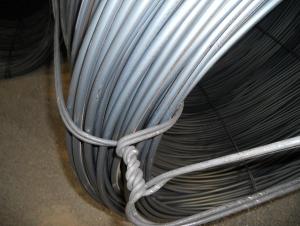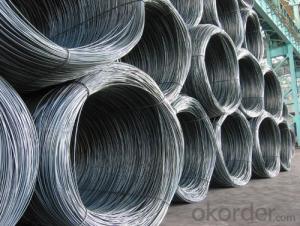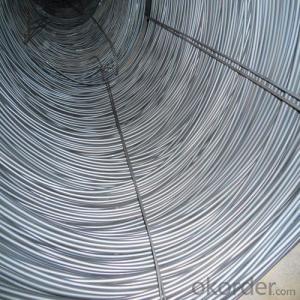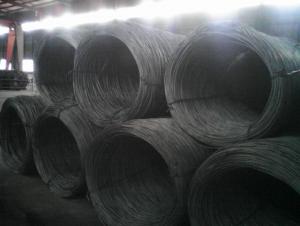Hot Rolled Low Carbon Steel Wire Rods for Nails, Steel Wire Mesh
- Loading Port:
- Tianjin
- Payment Terms:
- TT or LC
- Min Order Qty:
- 25 m.t.
- Supply Capability:
- 100000 m.t./month
OKorder Service Pledge
OKorder Financial Service
You Might Also Like
Product Description:
OKorder is offering Hot Rolled Low Carbon Steel Wire Rods for Nails, Steel Wire Mesh at great prices with worldwide shipping. Our supplier is a world-class manufacturer of steel, with our products utilized the world over. OKorder annually supplies products to African, South American and Asian markets. We provide quotations within 24 hours of receiving an inquiry and guarantee competitive prices.
Product Applications:
Hot Rolled Low Carbon Steel Wire Rods for Nails, Steel Wire Mesh are ideal for structural applications and are widely used in construction and manufacturing. Carbon steel wire rod is mainly used for reinforcement of reinforced concrete and welded structure or reprocessed (roberts , nail, etc.) materials, especially used to produce wire drawing, welding electrode, nails, spring, electronic, precise machinery parts and so on.
Product Advantages:
OKorder's Hot Rolled Low Carbon Steel Wire Rods for Nails, Steel Wire Mesh are durable, strong, and wide variety of sizes. They are newly produced by good quality steel billets.
Main Product Features:
· Premium quality
· Prompt delivery & seaworthy packing (30 days after receiving deposit)
· Can be recycled and reused
· Mill test certification
· Professional Service
· Competitive pricing
Product Specifications:
Steel Grade: SAE1006-1018B
Standard: ASTM, GB
Diameter: 5.5mm, 6.5mm, 7mm,8mm,9mm,10mm,12mm,14mm
Type: in coil, coil weight around 2MT
Alloy or Not: Alloy
Technique: Hot Rolled
Place of Origin: China Mainland
Surface: round, no twisted, light and smooth
FAQ:
Q1: Why buy Hot Rolled Low Carbon Steel Wire Rods for Nails, Steel Wire Mesh from OKorder.com?
A1: All products offered byOKorder.com are carefully selected from China's most reliable manufacturing enterprises. Through its ISO certifications, OKorder.com adheres to the highest standards and a commitment to supply chain safety and customer satisfaction.
Q2: How do we guarantee the quality of our products?
A2: We have established an advanced quality management system which conducts strict quality tests at every step, from raw materials to the final product. At the same time, we provide extensive follow-up service assurances as required.
Q3: How soon can we receive the product after purchase?
A3: Within three days of placing an order, we will arrange production. The normal sizes with the normal grade can be produced within one month. The specific shipping date is dependent upon international and government factors, the delivery to international main port about 45-60days.
Images:
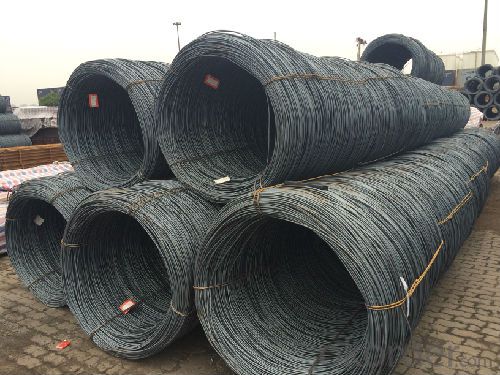

- Q:What are the different types of steel wire rod surface cleaning methods for wire galvanizing flux?
- There are several types of steel wire rod surface cleaning methods used for wire galvanizing flux. These include mechanical cleaning methods such as abrasive blasting or shot blasting, chemical cleaning methods like pickling or acid cleaning, and electrolytic cleaning methods. Each method has its own advantages and suitability depending on the specific requirements and condition of the steel wire rod.
- Q:What are the different production processes involved in steel wire rod manufacturing?
- Steel wire rod manufacturing involves a series of production processes that are essential for converting raw materials into the final product. Below are the different production processes employed in steel wire rod manufacturing: 1. Ironmaking: The manufacturing process of steel wire rods commences with ironmaking. Iron ore is extracted and processed in a blast furnace to produce pig iron. Subsequently, the pig iron is refined further to eliminate impurities and create steel. 2. Steelmaking: During the steelmaking process, the pig iron is melted in a furnace and combined with various elements like carbon, manganese, and silicon to achieve the desired steel properties. This process ensures that the steel meets the specific requirements for wire rod production. 3. Continuous Casting: Following steelmaking, the molten steel is cast into billets or blooms using continuous casting technology. This process involves pouring the molten steel into a water-cooled mold to solidify it into a predetermined shape. For wire rod production, the billets are typically cast in a square cross-section. 4. Hot Rolling: The subsequent stage is hot rolling, wherein the billets are reheated and passed through a series of rolling mills. These rolling mills reduce the cross-sectional area of the billets and elongate them into wire rod form. The hot rolling process enhances the mechanical properties and surface finish of the wire rods. 5. Cooling: Once the wire rods are hot rolled, they undergo a cooling process to achieve the desired properties. Depending on the wire rods' specific requirements, cooling can be accomplished through air cooling or water spray cooling. 6. Surface Treatment: After cooling, the wire rods undergo surface treatment processes such as pickling or coating. Pickling involves removing any scale or oxide present on the wire rods' surface using acid solutions. Coating may involve applying a protective layer to prevent corrosion or enhance the wire rods' performance in specific applications. 7. Inspection and Quality Control: Throughout the manufacturing process, the wire rods undergo stringent inspection and quality control measures. This guarantees that the wire rods meet the necessary standards and specifications. Various tests, including tensile strength, elongation, and dimensional checks, are conducted to ensure the wire rods' quality. 8. Packaging and Delivery: Lastly, the wire rods are packaged according to customer requirements and prepared for delivery. Depending on the customer's needs, they may be bundled, coil-wound, or packaged in other forms. The wire rods are then transported to the customers, where they can be further processed or utilized in various applications. These production processes play a crucial role in the manufacturing of steel wire rods, ensuring that they adhere to the required specifications and are suitable for diverse applications in industries such as construction, automotive, and manufacturing.
- Q:What are the different surface coatings used for steel wire rod?
- There are several different surface coatings used for steel wire rod, including zinc coating, galvanized coating, phosphate coating, and epoxy coating. Each coating provides different benefits such as corrosion resistance, improved adhesion, and enhanced durability.
- Q:How are steel wire rods used in the manufacturing of screws and bolts?
- Screws and bolts rely heavily on steel wire rods as a fundamental component in their production. These wire rods are utilized as the primary raw material from which screws and bolts are derived. To initiate the manufacturing process, careful selection of high-quality steel wire rods is conducted to ensure that they possess the necessary strength and durability characteristics required for screws and bolts. These wire rods are then subjected to a range of procedures, such as heating, rolling, and drawing, in order to transform them into thinner wire forms with precise dimensions. The drawn wire then undergoes a series of additional steps to create the specific shape and thread pattern essential for screws and bolts. For example, the wire may be cut into shorter lengths, and the ends are typically chamfered or beveled to facilitate easier insertion into materials. Once the wire has been shaped and prepared, it progresses to the threading process. This involves the creation of helical ridges on the wire, which will ultimately enable the screw or bolt to securely fasten objects together. The threading can be accomplished using various methods, such as rolling, cutting, or grinding, depending on the desired type of screw or bolt. Following the threading process, the wire is cut into individual pieces of the desired length, and the heads of screws or bolts are formed using diverse techniques, including cold forging or hot forging. Cold forging entails shaping the head by applying pressure to the cold wire, whereas hot forging involves heating the wire before shaping it. After the formation of the heads, the screws and bolts undergo additional procedures, such as heat treatment, surface coating, and quality control inspections. These measures guarantee that the final product meets the required standards for strength, corrosion resistance, and dimensional accuracy. In essence, steel wire rods play an indispensable role in the manufacturing of screws and bolts. They function as the initial material and undergo several processes, encompassing shaping, threading, and forming, to ultimately yield high-quality screws and bolts that find extensive use in numerous industries.
- Q:How is the steel wire rod market impacted by technological advancements?
- Technological advancements have significantly impacted the steel wire rod market by revolutionizing the manufacturing process, improving product quality, and enhancing operational efficiency. Advanced manufacturing techniques such as automation, robotics, and data analytics have streamlined production, leading to higher productivity and reduced costs. Furthermore, technological advancements in metallurgy and material science have resulted in the development of stronger and more durable wire rods, meeting the evolving demands of various industries. Additionally, innovations in wire rod coatings and surface treatments have expanded the range of applications and improved corrosion resistance. Overall, technological advancements have played a crucial role in shaping the steel wire rod market, driving growth, and enabling manufacturers to stay competitive in a rapidly changing industrial landscape.
- Q:How does the coating affect the performance of steel wire rod?
- The performance of steel wire rod can be significantly influenced by its coating. To begin with, the coating is essential for protecting the wire rod from corrosion, especially when it is exposed to moisture or harsh environments. This protective layer ensures that the wire rod maintains its strength and durability over time, reducing the risk of premature failure. Moreover, the coating can enhance the lubricity of the wire rod, making it easier to handle and minimizing friction during processing. As a result, wire drawing operations can be smoother, decreasing the likelihood of surface defects or breakages. Additionally, the coating can improve the bonding properties of the wire rod, particularly in applications such as welding or concrete reinforcement. A properly applied coating promotes better adhesion to other materials, ensuring the wire rod functions effectively in these specific applications. Furthermore, the coating can provide insulation properties, making the wire rod suitable for electrical or electronic uses. It prevents the wire rod from conducting electricity, lowering the risk of short circuits or electrical malfunctions. In summary, the coating on steel wire rod plays a vital role in protecting, enhancing, and optimizing its performance in various applications. It guarantees durability, improves handling, enhances bonding properties, and provides necessary insulation. Therefore, choosing the appropriate coating for specific applications is crucial to achieve optimal performance and longevity of steel wire rod.
- Q:How does steel wire rod compare to other materials for wire production?
- Steel wire rod is widely regarded as one of the superior materials for wire production due to its exceptional strength, durability, and versatility. Compared to other materials such as copper, aluminum, and brass, steel wire rod offers several distinct advantages. Firstly, steel wire rod exhibits superior tensile strength, making it highly resistant to breakage or deformation under heavy loads or extreme conditions. This strength is crucial in applications where wire is used for supporting structures or carrying heavy loads, ensuring the wire remains intact and reliable. Secondly, steel wire rod has excellent corrosion resistance properties, especially when compared to materials like copper or brass. This makes it an ideal choice for wire production in outdoor or high-moisture environments, where protection against rust and degradation is essential for the longevity and performance of the wire. Additionally, steel wire rod is known for its exceptional ductility, allowing it to be easily shaped and formed into various wire types and sizes. This flexibility makes it suitable for a wide range of applications, from electrical wiring to fencing, automotive components, and construction materials. Furthermore, steel wire rod is relatively cost-effective compared to materials like copper, making it a more economical choice for wire production without compromising on quality or performance. Its widespread availability and production efficiency contribute to its affordability. In summary, steel wire rod surpasses other materials in wire production due to its exceptional strength, corrosion resistance, ductility, and cost-effectiveness. Its versatile nature and reliability make it an ideal choice for a wide range of applications, making steel wire rod the preferred material in the wire industry.
- Q:How is steel wire rod used in the production of wire mesh filters?
- Steel wire rod is used in the production of wire mesh filters as it serves as the primary raw material for manufacturing the wire mesh. The steel wire rod is first drawn, stretched, and shaped into thin wires of various diameters. These wires are then woven or welded together to create a mesh pattern, which forms the structure of the wire mesh filter. The strength and durability of the steel wire rod ensure that the wire mesh filters can withstand high temperatures, corrosion, and mechanical stress, making them ideal for various filtration applications.
- Q:How are steel wire rods used in the production of reinforcements for concrete?
- The production of reinforcements for concrete heavily relies on steel wire rods. Utilizing high-quality steel, these wire rods undergo a process known as hot rolling to be manufactured. Within the realm of concrete reinforcement production, steel wire rods serve as the building blocks for various types of reinforcements. Wire mesh, rebar, and welded wire fabric are among the creations resulting from these rods. These reinforcements are incorporated into concrete structures to bolster their strength, endurance, and resistance against cracks. To fashion wire mesh, steel wire rods undergo initial straightening, followed by cutting into desired lengths. Subsequently, these lengths are welded together, forming a grid-like pattern. Within the concrete structure, the wire mesh contributes tensile strength, effectively preventing the formation and propagation of cracks. Rebar, another prevalent reinforcement, involves bending and cutting steel wire rods into specific shapes and sizes. These rebars find their place embedded within the concrete, offering structural support and fortifying the concrete against tension forces. Columns, beams, and slabs frequently employ rebars to ensure the soundness of concrete structures. Steel wire rods can also be utilized in the production of welded wire fabric, which constitutes intersecting steel wires. At the points of intersection, the wires are welded together, generating a resilient mesh. Welded wire fabric frequently finds application in larger concrete structures like bridges and highways, effectively distributing loads and averting cracks. In summary, steel wire rods occupy a crucial role in the realm of concrete reinforcement production. By supplying the requisite strength, durability, and crack resistance, these rods guarantee the stability and longevity of concrete structures.
- Q:What are the international standards for steel wire rod?
- The international standards for steel wire rod include specifications for chemical composition, mechanical properties, dimensions, and tolerances. These standards are set by organizations such as the International Organization for Standardization (ISO) and the American Society for Testing and Materials (ASTM). They ensure that steel wire rods meet certain quality and performance requirements, allowing for consistent and reliable use in various industries worldwide.
1. Manufacturer Overview |
|
|---|---|
| Location | |
| Year Established | |
| Annual Output Value | |
| Main Markets | |
| Company Certifications | |
2. Manufacturer Certificates |
|
|---|---|
| a) Certification Name | |
| Range | |
| Reference | |
| Validity Period | |
3. Manufacturer Capability |
|
|---|---|
| a)Trade Capacity | |
| Nearest Port | |
| Export Percentage | |
| No.of Employees in Trade Department | |
| Language Spoken: | |
| b)Factory Information | |
| Factory Size: | |
| No. of Production Lines | |
| Contract Manufacturing | |
| Product Price Range | |
Send your message to us
Hot Rolled Low Carbon Steel Wire Rods for Nails, Steel Wire Mesh
- Loading Port:
- Tianjin
- Payment Terms:
- TT or LC
- Min Order Qty:
- 25 m.t.
- Supply Capability:
- 100000 m.t./month
OKorder Service Pledge
OKorder Financial Service
Similar products
New products
Hot products
Hot Searches
Related keywords

